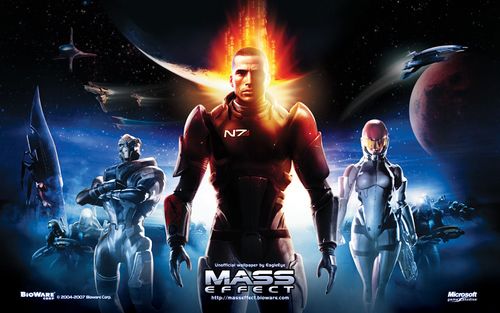Due to issues with fake accounts being created all account creation is now managed by the Systems Operator and Manager of the D6 Holocron. If you wish to have an account created at all please be sure to E-mail bsdoblivion@d6holocron.com with your requested alias. (((>*.*<)))
Mass Effect Human
Name: Human
Dice: 12D
Dexterity: 1D / 4D
Knowledge: 1D / 4D
Mechanical: 1D / 4D
Perception: 1D / 4D
Strength: 1D / 4D
Technical: 1D / 4D
Move: 10 / 12
Size: 1.4 - 1.98 m
Weight: 40 - 127 kg
Special Abilities:
- Quick to Master: A human gains a bonus free Skill Specialization at character creation. They are quick to master specialized tasks.
- Skilled: Humans gain +1D+1 skill dice at character creation. They are versatile and capable.
Description: Humans, from the planet Earth, are the newest sentient species of notable size to enter the galactic stage and are the most rapidly expanding and developing. In 2148, human explorers on Mars uncovered a long-ruined prothean observation post, with a surviving data cache that proved protheans had studied Cro-Magnon humans millennia ago. While religions tried to assimilate this discovery into their doctrine, a global rush began to decipher the petabytes of data from the outpost. Discovering information on a mass relay orbiting Pluto, explorers managed to open the Charon Relay and discovered it led to Arcturus. With the help of the fledgling Systems
Alliance, humans expanded to other systems, opening any mass relays they could find. Humans are generally seen to be very intelligent, abnormally ambitious, highly adaptable, individualistic and thus, unpredictable. They have a powerful desire to advance and improve themselves, and do so with such assertion that the normally staid Council races have been taken aback by their restlessness and relentless curiosity. Their economy, while much smaller than any of the Council races, is very powerful relative to their size, and their military prowess is among the greatest in the galaxy, despite the fact that only 3% of humans volunteer for the Alliance military, a far smaller proportion than other races. Their ability to defeat the turians in the First Contact War demonstrated graphically the potential of human military strength and is therefore a subject of concern for many races, who fear the consequences of another human-turian conflict.
Humans first came to the attention of the galactic community after a brief but intense conflict with the turians, known by humans as the First Contact War, begun in 2157. The conflict began when the turians attacked a human fleet attempting to activate a dormant mass relay (illegal under Council law) and then occupied the human colony of Shanxi.
Led by Admiral Kastanie Drescher, the Second Fleet then launched a massive counter-attack, which caught the turians by surprise and expelled them from Shanxi. The conflict caught the attention of the Citadel Council, which wasted no time brokering a peace, thus introducing humans to the galactic community. As a consequence of the Alliance's swift and decisive action during the First Contact War, the Alliance became the representative and supranational governing body of humanity. Since then, humans have rapidly risen in prominence.
In 2165, humanity was granted an embassy on the Citadel in recognition of their growing power and influence in the galactic community. The timing of this achievement, less than a decade after first contact, caused some friction with other Citadel races who had waited decades for such recognition.
Humanity continued to expand to unclaimed star systems on the edge of Citadel space, which eventually led to competition with the batarians. When the batarians tried and failed to convince the Council to declare the Skyllian Verge "a zone of batarian interest", they closed their embassy and withdrew from Citadel space. Viewing humans as the cause of their fall from grace, batarians frequently came into conflict with human colonies, especially batarian slavers. Tensions between humans and batarians persist for decades.
Unlike many species in Citadel space, humans have no close allies among the other races, though they are trade partners with the turians and asari. Without alliances or key political positions, humans have had to follow the edicts of the Council without having much influence on their decisions. Human ambassadors finally had their wishes answered when Shepard was admitted into the Spectres, the Council's elite operatives, and even further when they were given a seat on the Council, after either having saved them from the Battle of the Citadel, or having Humanity rebuild the Council when they were lost. However, now that Humanity has a seat on the Council, they are able to influence the Council's rulings, protect their own interests and have a say in the governing of Citadel space.
Personality: Due to the diversity of human characters it is very hard to profile Humans with one definite personality.
Physical Description: Humans have a fairly robust physiology. Their internal makeup and reproductive processes are typical of most bipedal mammals and their size and proportions give the appearance of being strong, fast and agile. In comparison to the Council races, humans are roughly physically on par with Turians.
Homeworld: Earth
Religion: Like the Turians, Humans are free to practice whatever religion that suits them.
Biotics: After a series of starship accidents in the 2150s which dispersed element zero over populated areas, the first human biotics were born, though their abilities were not recognized right away. By the time these children were teenagers, the Alliance had made contact with the Citadel and learned of the effects of in-utero eezo exposure. A company called Conatix Industries was founded to track down exposed individuals and develop implants for humans. There are rumours that, after the link between eezo and biotics was discovered, some human colonies were deliberately exposed to dust-form element zero to create more biotic children.
Example Names: John Sheppard.
Source:
- Mass Effect Wiki: Human
- Mass Effect d20 RPG (pages 23-25)
- thedemonapostle
